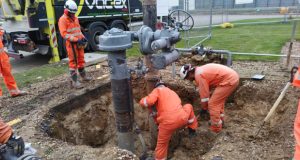 Tim Strutt, Electronic Temperature Instruments (ETI) uncovers the latest developments in legionella testing and how these support facilities managers
Tim Strutt, Electronic Temperature Instruments (ETI) uncovers the latest developments in legionella testing and how these support facilities managers
Legionella is a type of bacteria that thrives in warm water environments, especially in building systems where stagnant or aerosolised water is present. These bacteria can cause Legionnaires’ disease, a potentially fatal form of pneumonia in humans.
Though outbreaks are rare, they do happen – and infection can be deadly for certain groups, including older adults, smokers and heavy drinkers, and those with chronic illnesses or weakened immune systems. In August 2002, seven people died and 180 suffered ill health due to a legionella outbreak at a council-owned arts and leisure facility in Barrow-in-Furness, Cumbria.
WHERE IS MOST AT RISK?
Specific factors make certain property types more susceptible to legionella. The risk is higher in buildings that have large, complex water systems with long pipe runs, high hot water demand with potential for stagnation if taps or showers are used infrequently, and inconsistent maintenance schedules. While all business owners have a statutory duty to prevent legionella exposure, those responsible for residential accommodation, large offices, universities, schools, hospitals, care homes, hotels, and other hospitality sites face heightened concerns due to the increased risk to occupants.
It’s easy to see how these factors might have increased the risk in office buildings. The recent boom in hybrid working means employees are on-site less frequently, leaving parts of the water system potentially underused for longer periods than they would have been before 2020. Likewise, rental properties and guest houses face increased risk during the off-season, when low guest turnover leads to stagnant water in pipes, taps, and showers.
Across these sites, legionella can contaminate or grow in different artificial water systems. The most common include cooling towers, evaporation condensers, air conditioning and industrial cooling systems, humidifiers, spa baths, and hot and cold-water systems.
THE FACILITIES MANAGER’S DUTY
The Approved Code of Practice for ‘Legionnaires’ disease: The control of legionella bacteria (ACOP L8) is a guidance document issued by the UK Health and Safety Executive (HSE). It provides practical advice on how to control legionella bacteria in water systems, while complying with the relevant health and safety regulations. While not legally binding, ACOP L8 ensures facilities managers follow best practice and reduce potential liability. If someone is prosecuted for breaching health and safety law but can demonstrate they have followed the guidance, they would likely be compliant.
That said, the most recent iteration of ACOP L8 significantly extends the scope of its guidance on control of legionella bacteria in water. The code now applies to all hot- and cold-water systems in the workplace regardless of their capacity (the lower limit of 300 litres previously used to exclude domestic systems no longer applies). While domestic systems may represent a risk, the code only applies to risk arising from a work activity. As a result, facilities managers on premises with hot-and cold-water systems and / or wet cooling systems have a legal responsibility to identify any risk of contamination and to prevent or control it.
TEMPERATURE MATTERS
Incorrect water temperature is a massive risk factor for legionella growth. The bacteria multiply in water at temperatures between 20°C and 45°C, particularly if a supply of nutrients is present, such as scale, rust, sludge or algae. A typical method of control is to store cold water below 20°C. Hot water should be stored above 60°C and distributed at over 50 °C – though care must be taken to prevent scalding.
Taking temperature measurements is the easy part. A thermometer and various probes may be used to monitor the temperature of both standing water and the surface of pipes and tanks that form part of the water system. An immersion probe should be placed in the water at a minimum depth of 25mm. A ribbon surface probe can take the temperature of pipes and tanks. Alternatively, a wire probe will reach awkward places or where the other probes are not appropriate.
The really challenging bit is in identifying the risks, with an emphasis on where water is stored and distributed, as well as keeping records of any risk assessments, testing and maintenance.
As part of the risk assessment, facilities managers must map the water system to locate all points of storage, such as tanks and calorifiers, and distribution, including pipework and outlets. The next step is to identify rarely used outlets where water may stagnate and check temperature ranges throughout the system to spot areas between the acceptable parameters. Finally, facilities managers should consider keeping an accurate digital record by integrating the data with their FM technology systems, which can send alerts and help identify patterns or anomalies.
According to the UK Health Security Agency, there were 604 confirmed cases of Legionnaires’ disease in England and Wales in 2023. Though this represents an increase from previous years, the good news is that it’s most likely down to enhanced testing and diagnostic practices. Nevertheless, legionella remains a constant threat for facilities managers, who must do all they can to protect occupants and businesses from the bacteria’s harmful effects.





